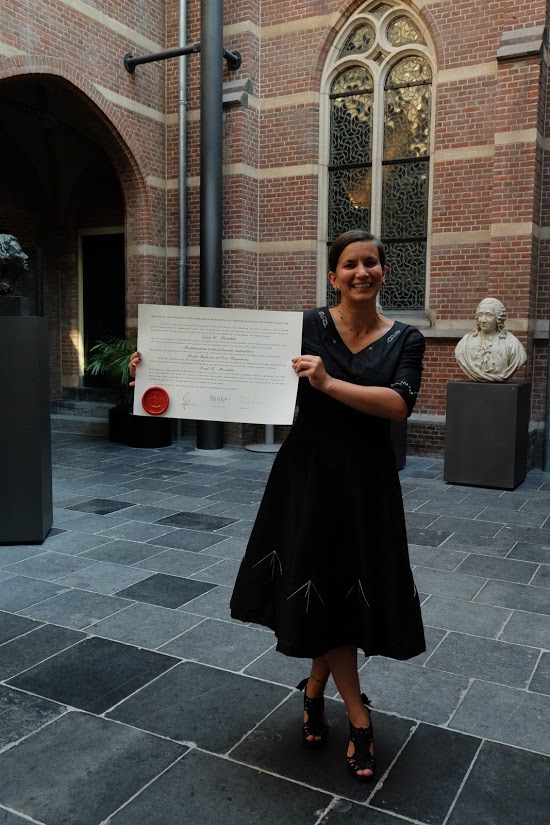Daily Image
29-11-2016Leah Morabito succesfully defends her PhD thesis
| Submitter: | Raymond Oonk, Huib Jan van Langevelde, Raffaella Morganti |
| Description: | On September 13th Leah Morabito, successfully defended her PhD thesis in Leiden. The thesis on "Radio Emission Galaxies at Low Frequencies: high spatial and spectral resolution studies with LOFAR", was supervised by Huub Rottgering and George Miley. The picture shows Leah proudly presenting her doctorate. Congratulations! For the occasion she created a special dress in the spirit of her thesis, showing how she boldly and successfully used the LOFAR Low Band Antennas (LBA: displayed on the hem of the dress) to observe both the nearby universe (M82: displayed on the sleeves) and the far-away universe (4C 43.15: displayed on the collar) Leah's thesis focused on detecting the lowest-frequency radio emission from radio galaxies. In the nearby universe she observed the famous nearby starburst galaxy M82 in the 48-64 MHz range and made the first extragalactic discovery of carbon radio recombination lines ( http://www.astron.nl/dailyimage/pictures/20141028/drawing2.jpg ). These spectral lines provide an excellent tracer of the physical conditions in the cold neutral medium and had sofar only been observed in our own Milky Way. With the increased sensitivity and resolution offered by LOFAR she has shown that it is now possible to detect these lines in other galaxies and potentially out to very large distances. Her next step was to go out and observe the continuum morphology on arcsecond-scales in far-away, radio galaxies. For this she had to use the full international capabilities of LOFAR and succesfully mapped the enigmatic FRII radio source source 4C 43.15 ( http://www.astron.nl/dailyimage/pictures/20160812/combined.png ) on 0.9 arcsec by 0.6 arcsec scales at 55 MHz! This is first sub-arcsecond resolution image below 100 MHz. Combination of the LOFAR image with higher frequency VLA data shows that the ultra-steep radio lobes of this galaxy have a break at low frequencies, and implies that distant radio galaxies are fundamentally the same as their local counterparts. Along the way Leah contributed greatly to improving the calibration of the international baselines for LOFAR. During her PhD work Leah was a frequent guest at ASTRON. She has now moved to Oxford to continue her work with LOFAR as a Postdoc at the University of Oxford. Good luck for your future career, full of exciting LOFAR results! |
| Copyright: | H.J. van Langevelde |
| Tweet |  |
